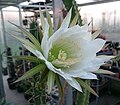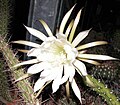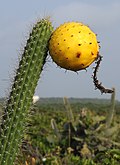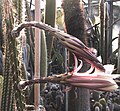| Harrisia | |
|---|---|

| |
| Harrisia gracilis and Harrisia martinii | |
| Scientific classification | |
| Kingdom: | Plantae |
| Clade: | Tracheophytes |
| Clade: | Angiosperms |
| Clade: | Eudicots |
| Order: | Caryophyllales |
| Family: | Cactaceae |
| Subfamily: | Cactoideae |
| Tribe: | Cereeae |
| Subtribe: | Trichocereinae |
| Genus: | Harrisia Britton |
| Type species | |
| Harrisia gracilis | |
| Species | |
| Synonyms | |
| |
Harrisia (applecactus and moonlight cactus) is a genus of night blooming cacti.
Description
They are tree-shaped, sometimes climbing or shrub-like cacti with cylindrical shoots. They reach heights of up to 7 m. The shoots are ribbed (four to twelve ribs) and do not form aerial roots. The flowers open at night, are white and up to 12 cm in diameter. After successful pollination, rounded fruits are formed, which are red to orange in color. The fruits have scales with areoles in the axils. The black seeds are 2 to 3 × 1.5 mm in size.
Distribution
Plants are native to Argentina, Paraguay, Brazil, Bolivia, Uruguay, the Greater Antilles, the Bahamas, and the U.S. state of Florida. The genus is named after William Harris, an important botanist of Jamaica. There are about 20 species.
Harrisia cactus is an exotic invasive in Queensland, Africa, and the U.S. state of Hawaii.
Taxonomy
The genus was established by Nathaniel Lord Britton in 1909.
Species
As of September 2023, Plants of the World Online accepted the following species separated into two subgenera:
| Subgenus | Image | Scientific name | Distribution |
|---|---|---|---|
| Eriocereus (A. Berger) A.R. Franck |  |
Harrisia tetracantha (Labour.) D.R.Hunt | Bolivia. |
 |
Harrisia regelii (Weing.) Borg | Argentina (Santa Fé, Entre Ríos) to Uruguay. | |
 |
Harrisia martinii (Labour.) Britton | E. Paraguay to NE. Argentina. | |
 |
Harrisia bonplandii (J.Parm. ex Pfeiff.) Britton & Rose | Paraguay, Argentina, Bolivia | |
 |
Harrisia pomanensis (F.A.C.Weber ex K.Schum.) Britton & Rose | Argentina, Bolivia, Paraguay | |
 |
Harrisia tortuosa (J.Forbes) Britton & Rose | Bolivia to Uruguay. | |
| Harrisia |  |
Harrisia aboriginum Small ex Britton & Rose | Florida, on the Gulf Coast of the counties of Lee, Sarasota County, and Charlotte |
| Harrisia adscendens (Gürke) Britton & Rose | Brazil | ||
 |
Harrisia brookii Britton | Bahamas. | |
| Harrisia caymanensis A.R.Franck | Cayman Islands, Swan Islands. | ||
 |
Harrisia divaricata (Lam.) Backeb. | Hispaniola. | |
 |
Harrisia earlei Britton & Rose | Cuba | |
| Harrisia eriophora (Pfeiff.) Britton | Cuba. | ||
| Harrisia fernowii Britton | Cuba. | ||
 |
Harrisia fragrans Small ex Britton & Rose | St. Lucie County, Florida | |
| Harrisia gracilis (Mill.) Britton | Jamaica | ||
 |
Harrisia portoricensis Britton | Puerto Rico | |
 |
Harrisia taetra Areces | Cuba. |
References
- ^ "Harrisia Britton". Plants of the World Online. 2020-11-18. Retrieved 2023-09-29.
- NRCS. "Harrisia". PLANTS Database. United States Department of Agriculture (USDA). Retrieved 10 May 2015.
- ^ "Harrisia cactus" (PDF). Biosecurity Queensland. The State of Queensland, Department of Agriculture, Fisheries and Forestry. 2013. Retrieved 23 February 2017.
- "Harrisia Cactus". HerbiGuide. Retrieved 23 February 2017.
- Anderson, Edward F.; Eggli, Urs (2005). Das grosse Kakteen-Lexikon (in German). Stuttgart (Hohenheim): Ulmer. p. 337–341. ISBN 3-8001-4573-1.
- Flora of North America
- Department of Agriculture, Fisheries and Forestry: Biosecurity Queensland (1 January 2016). "Prohibited invasive plants: Harrisia cactus". Business Queensland. Queensland Government. Retrieved 20 February 2017.
- Franck, Alan R. (2016). "MONOGRAPH OF HARRISIA" (PDF). Phytoneuron. Retrieved 2023-11-25.
External links
- [REDACTED] Media related to Harrisia at Wikimedia Commons
- [REDACTED] Data related to Harrisia at Wikispecies
| Taxon identifiers | |
|---|---|
| Harrisia |
|